TOYOTA BZ4X 2022 Owners Manual (in English)
Manufacturer: TOYOTA, Model Year: 2022, Model line: BZ4X, Model: TOYOTA BZ4X 2022Pages: 674, PDF Size: 120.02 MB
Page 531 of 674
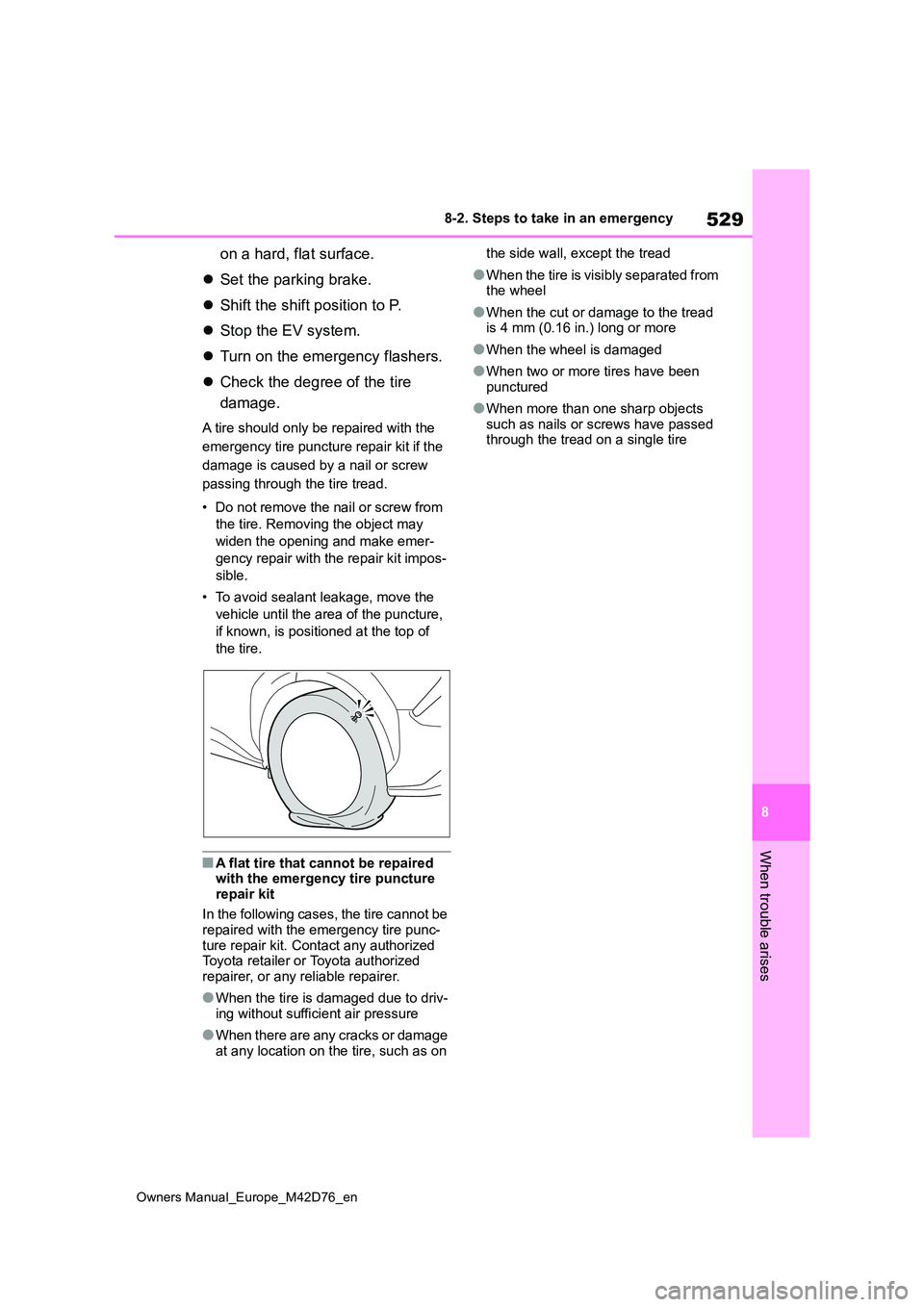
529
8
Owners Manual_Europe_M42D76_en
8-2. Steps to take in an emergency
When trouble arises
on a hard, flat surface.
Set the parking brake.
Shift the shift position to P.
Stop the EV system.
Turn on the emergency flashers.
Check the degree of the tire
damage.
A tire should only be repaired with the
emergency tire puncture repair kit if the
damage is caused by a nail or screw
passing through the tire tread.
• Do not remove the nail or screw from
the tire. Removing the object may
widen the opening and make emer-
gency repair with the repair kit impos-
sible.
• To avoid sealant leakage, move the
vehicle until the area of the puncture,
if known, is positioned at the top of
the tire.
■A flat tire that cannot be repaired with the emergency tire puncture
repair kit
In the following cases, the tire cannot be repaired with the emergency tire punc-
ture repair kit. Contact any authorized Toyota retailer or Toyota authorized repairer, or any reliable repairer.
●When the tire is damaged due to driv-ing without sufficient air pressure
●When there are any cracks or damage at any location on the tire, such as on
the side wall, except the tread
●When the tire is visibly separated from the wheel
●When the cut or damage to the tread is 4 mm (0.16 in.) long or more
●When the wheel is damaged
●When two or more tires have been punctured
●When more than one sharp objects such as nails or screws have passed through the tread on a single tire
Page 532 of 674
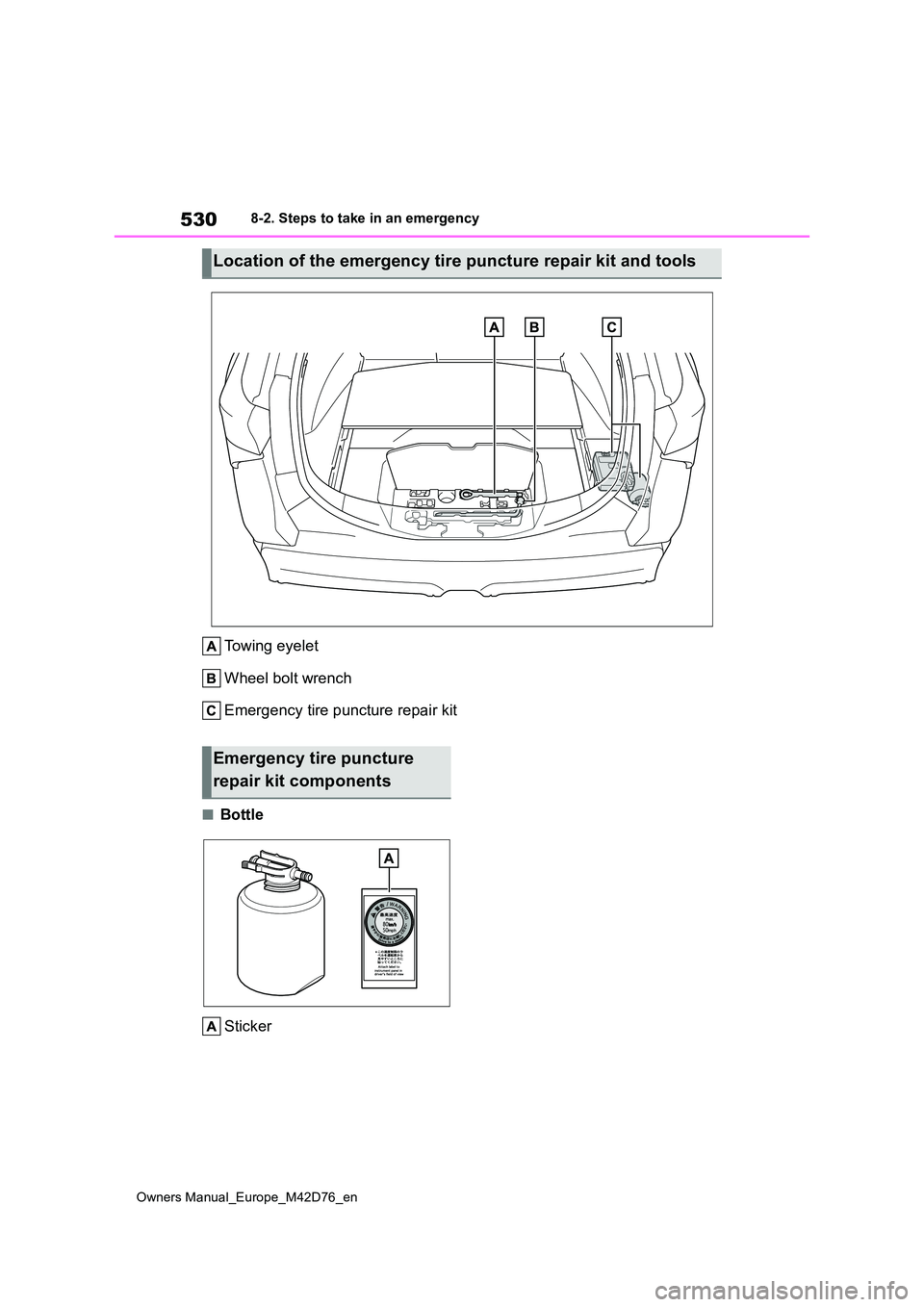
530
Owners Manual_Europe_M42D76_en
8-2. Steps to take in an emergency
Towing eyelet
Wheel bolt wrench
Emergency tire puncture repair kit
■Bottle
Sticker
Location of the emergency tire puncture repair kit and tools
Emergency tire puncture
repair kit components
Page 533 of 674
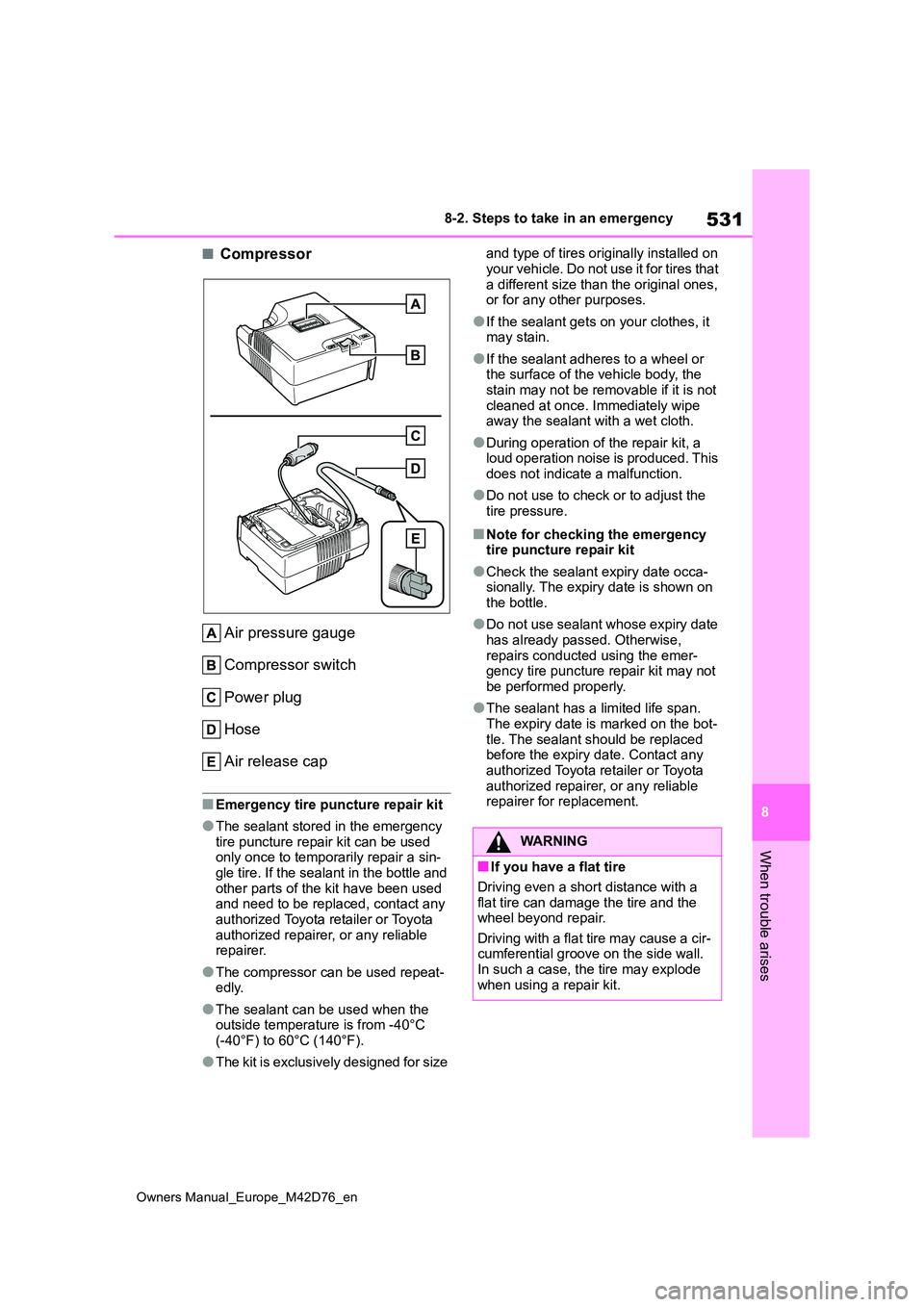
531
8
Owners Manual_Europe_M42D76_en
8-2. Steps to take in an emergency
When trouble arises
■Compressor
Air pressure gauge
Compressor switch
Power plug
Hose
Air release cap
■Emergency tire puncture repair kit
●The sealant stored in the emergency tire puncture repair kit can be used only once to temporarily repair a sin-
gle tire. If the sealant in the bottle and other parts of the kit have been used and need to be replaced, contact any
authorized Toyota retailer or Toyota authorized repairer, or any reliable repairer.
●The compressor can be used repeat-edly.
●The sealant can be used when the outside temperature is from -40°C
(-40°F) to 60°C (140°F).
●The kit is exclusively designed for size
and type of tires originally installed on
your vehicle. Do not use it for tires that a different size than the original ones, or for any other purposes.
●If the sealant gets on your clothes, it may stain.
●If the sealant adheres to a wheel or the surface of the vehicle body, the
stain may not be removable if it is not cleaned at once. Immediately wipe away the sealant with a wet cloth.
●During operation of the repair kit, a loud operation noise is produced. This
does not indicate a malfunction.
●Do not use to check or to adjust the
tire pressure.
■Note for checking the emergency tire puncture repair kit
●Check the sealant expiry date occa-sionally. The expiry date is shown on the bottle.
●Do not use sealant whose expiry date has already passed. Otherwise,
repairs conducted using the emer- gency tire puncture repair kit may not be performed properly.
●The sealant has a limited life span. The expiry date is marked on the bot-
tle. The sealant should be replaced before the expiry date. Contact any authorized Toyota retailer or Toyota
authorized repairer, or any reliable repairer for replacement.
WARNING
■If you have a flat tire
Driving even a short distance with a flat tire can damage the tire and the wheel beyond repair.
Driving with a flat tire may cause a cir- cumferential groove on the side wall. In such a case, the tire may explode
when using a repair kit.
Page 534 of 674
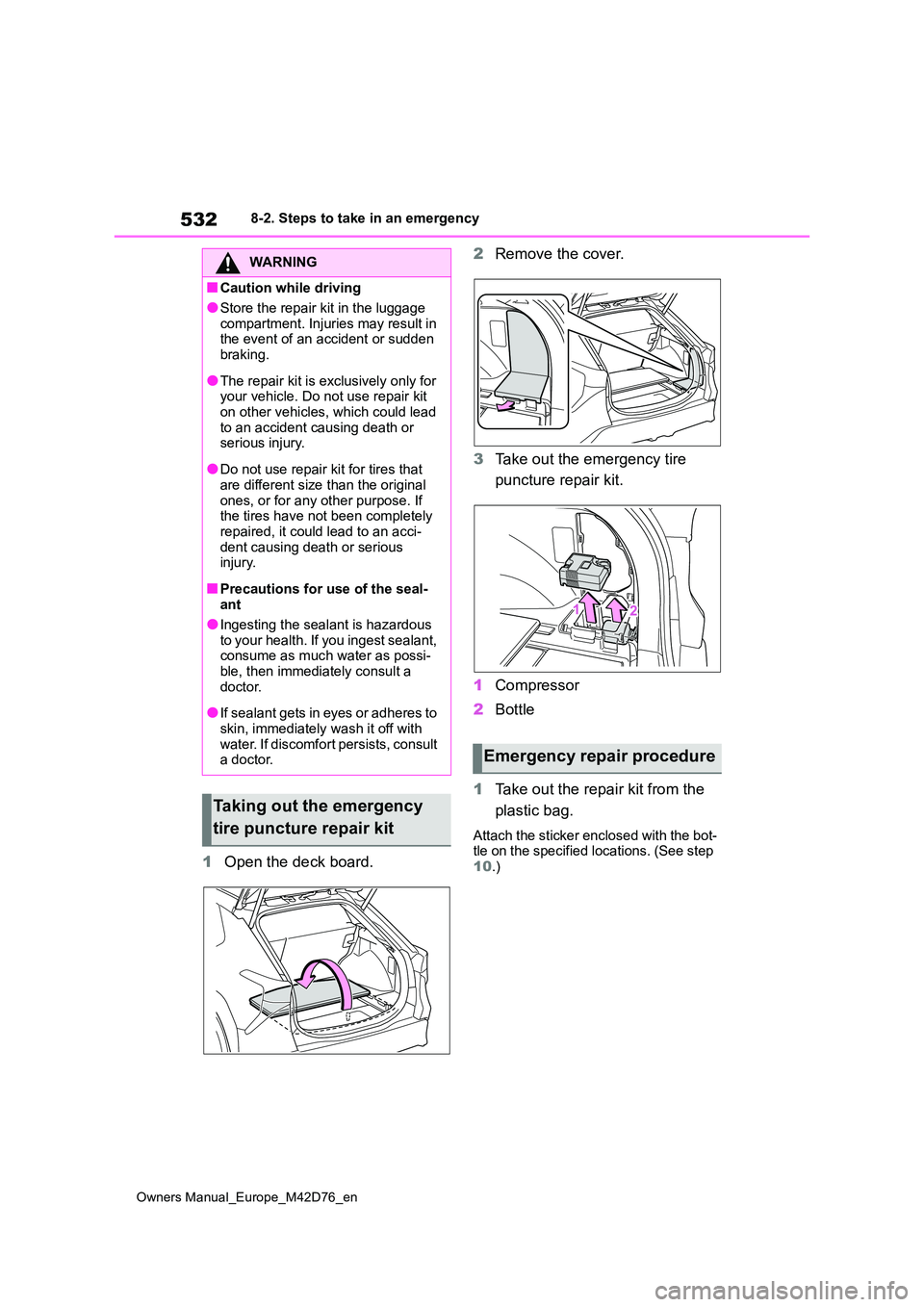
532
Owners Manual_Europe_M42D76_en
8-2. Steps to take in an emergency
1Open the deck board.
2 Remove the cover.
3 Take out the emergency tire
puncture repair kit.
1 Compressor
2 Bottle
1 Take out the repair kit from the
plastic bag.
Attach the sticker enclosed with the bot- tle on the specified locations. (See step 10 .)
WARNING
■Caution while driving
●Store the repair kit in the luggage
compartment. Injuries may result in the event of an accident or sudden braking.
●The repair kit is exclusively only for your vehicle. Do not use repair kit
on other vehicles, which could lead to an accident causing death or serious injury.
●Do not use repair kit for tires that are different size than the original
ones, or for any other purpose. If the tires have not been completely repaired, it could lead to an acci-
dent causing death or serious injury.
■Precautions for use of the seal-ant
●Ingesting the sealant is hazardous
to your health. If you ingest sealant, consume as much water as possi-ble, then immediately consult a
doctor.
●If sealant gets in eyes or adheres to
skin, immediately wash it off with water. If discomfort persists, consult a doctor.
Taking out the emergency
tire puncture repair kit
Emergency repair procedure
Page 535 of 674
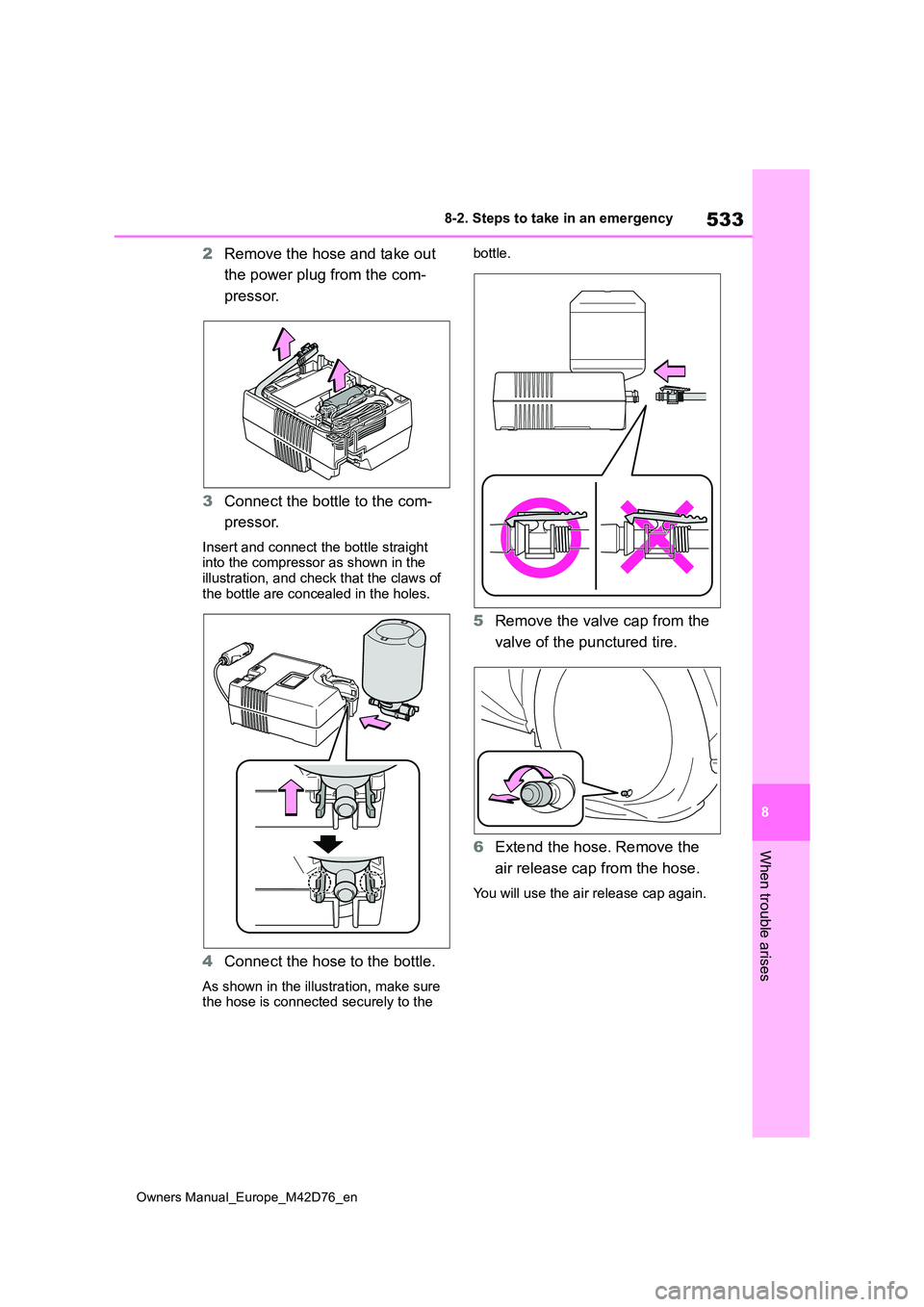
533
8
Owners Manual_Europe_M42D76_en
8-2. Steps to take in an emergency
When trouble arises
2Remove the hose and take out
the power plug from the com-
pressor.
3 Connect the bottle to the com-
pressor.
Insert and connect the bottle straight into the compressor as shown in the
illustration, and check that the claws of the bottle are concealed in the holes.
4 Connect the hose to the bottle.
As shown in the illustration, make sure the hose is connected securely to the
bottle.
5 Remove the valve cap from the
valve of the punctured tire.
6 Extend the hose. Remove the
air release cap from the hose.
You will use the air release cap again.
Page 536 of 674
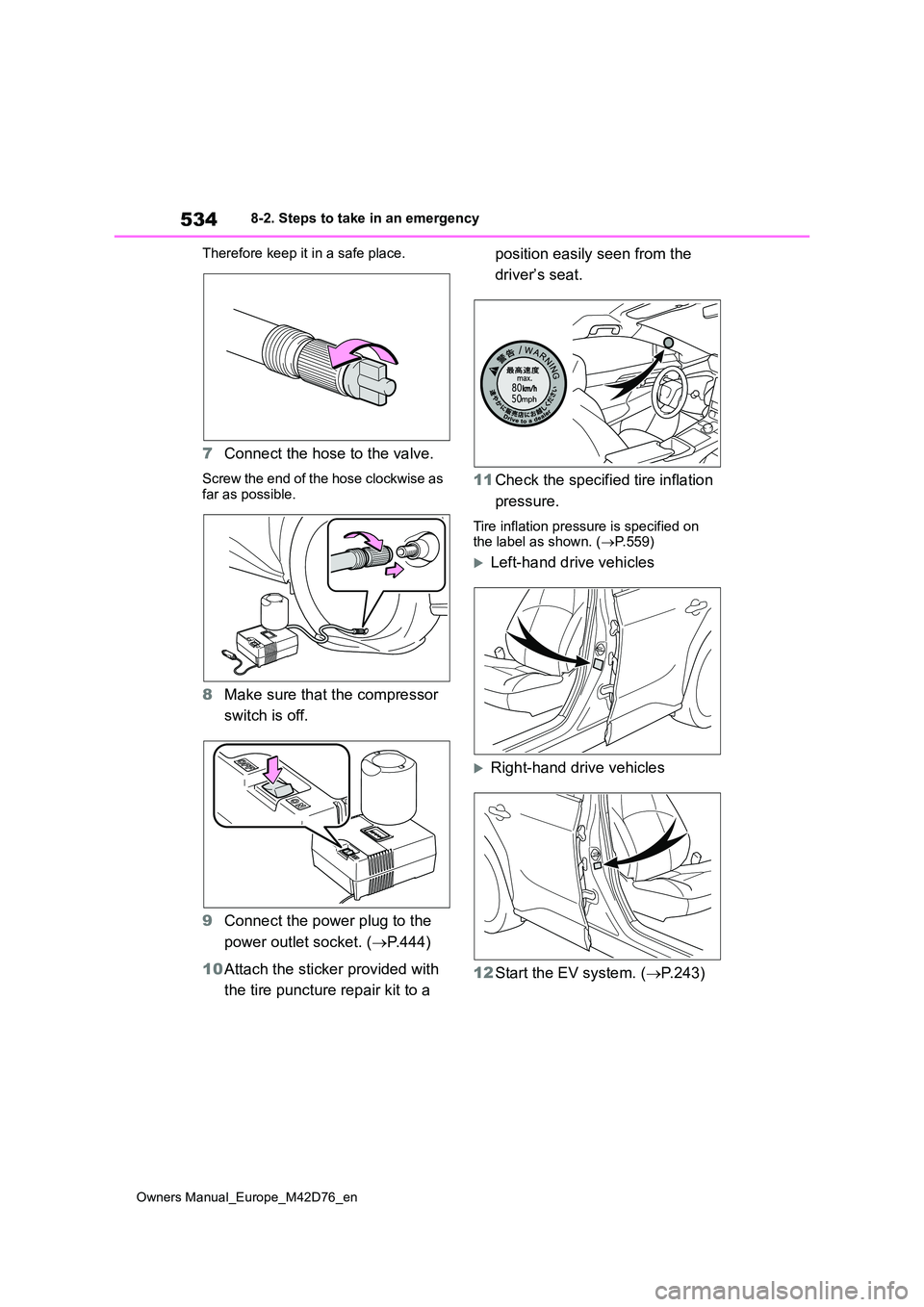
534
Owners Manual_Europe_M42D76_en
8-2. Steps to take in an emergency
Therefore keep it in a safe place.
7 Connect the hose to the valve.
Screw the end of the hose clockwise as
far as possible.
8 Make sure that the compressor
switch is off.
9 Connect the power plug to the
power outlet socket. ( P.444)
10 Attach the sticker provided with
the tire puncture repair kit to a
position easily seen from the
driver’s seat.
11 Check the specified tire inflation
pressure.
Tire inflation pressure is specified on the label as shown. ( P.559)
Left-hand drive vehicles
Right-hand drive vehicles
12 Start the EV system. (P.243)
Page 537 of 674
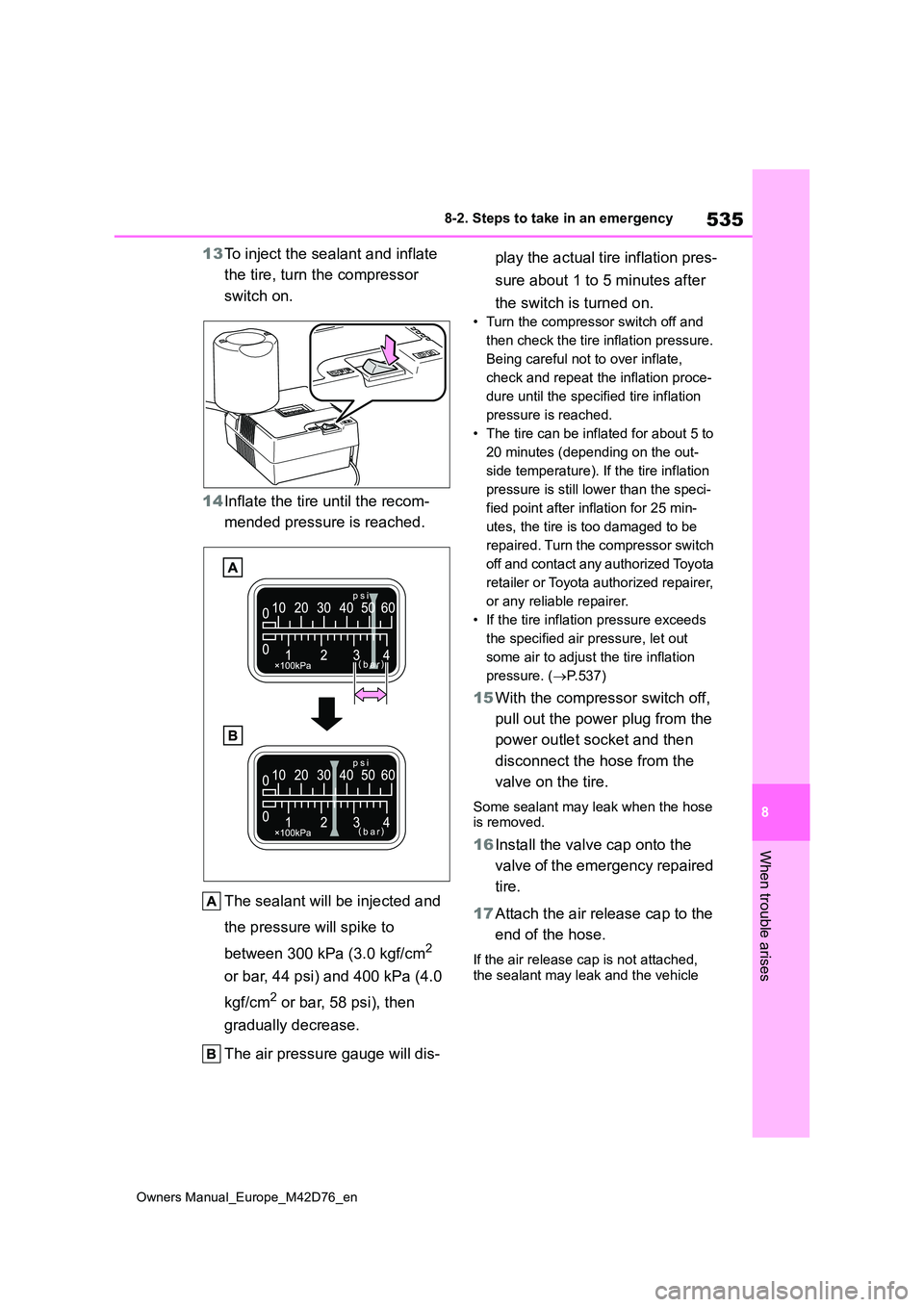
535
8
Owners Manual_Europe_M42D76_en
8-2. Steps to take in an emergency
When trouble arises
13To inject the sealant and inflate
the tire, turn the compressor
switch on.
14 Inflate the tire until the recom-
mended pressure is reached.
The sealant will be injected and
the pressure will spike to
between 300 kPa (3.0 kgf/cm2
or bar, 44 psi) and 400 kPa (4.0
kgf/cm2 or bar, 58 psi), then
gradually decrease.
The air pressure gauge will dis-
play the actual tire inflation pres-
sure about 1 to 5 minutes after
the switch is turned on.
• Turn the compressor switch off and
then check the tire inflation pressure.
Being careful not to over inflate,
check and repeat the inflation proce-
dure until the specified tire inflation
pressure is reached.
• The tire can be inflated for about 5 to
20 minutes (depending on the out-
side temperature). If the tire inflation
pressure is still lower than the speci-
fied point after inflation for 25 min-
utes, the tire is too damaged to be
repaired. Turn the compressor switch
off and contact any authorized Toyota
retailer or Toyota authorized repairer,
or any reliable repairer.
• If the tire inflation pressure exceeds
the specified air pressure, let out
some air to adjust the tire inflation
pressure. ( P.537)
15With the compressor switch off,
pull out the power plug from the
power outlet socket and then
disconnect the hose from the
valve on the tire.
Some sealant may leak when the hose is removed.
16 Install the valve cap onto the
valve of the emergency repaired
tire.
17 Attach the air release cap to the
end of the hose.
If the air release cap is not attached, the sealant may leak and the vehicle
Page 538 of 674
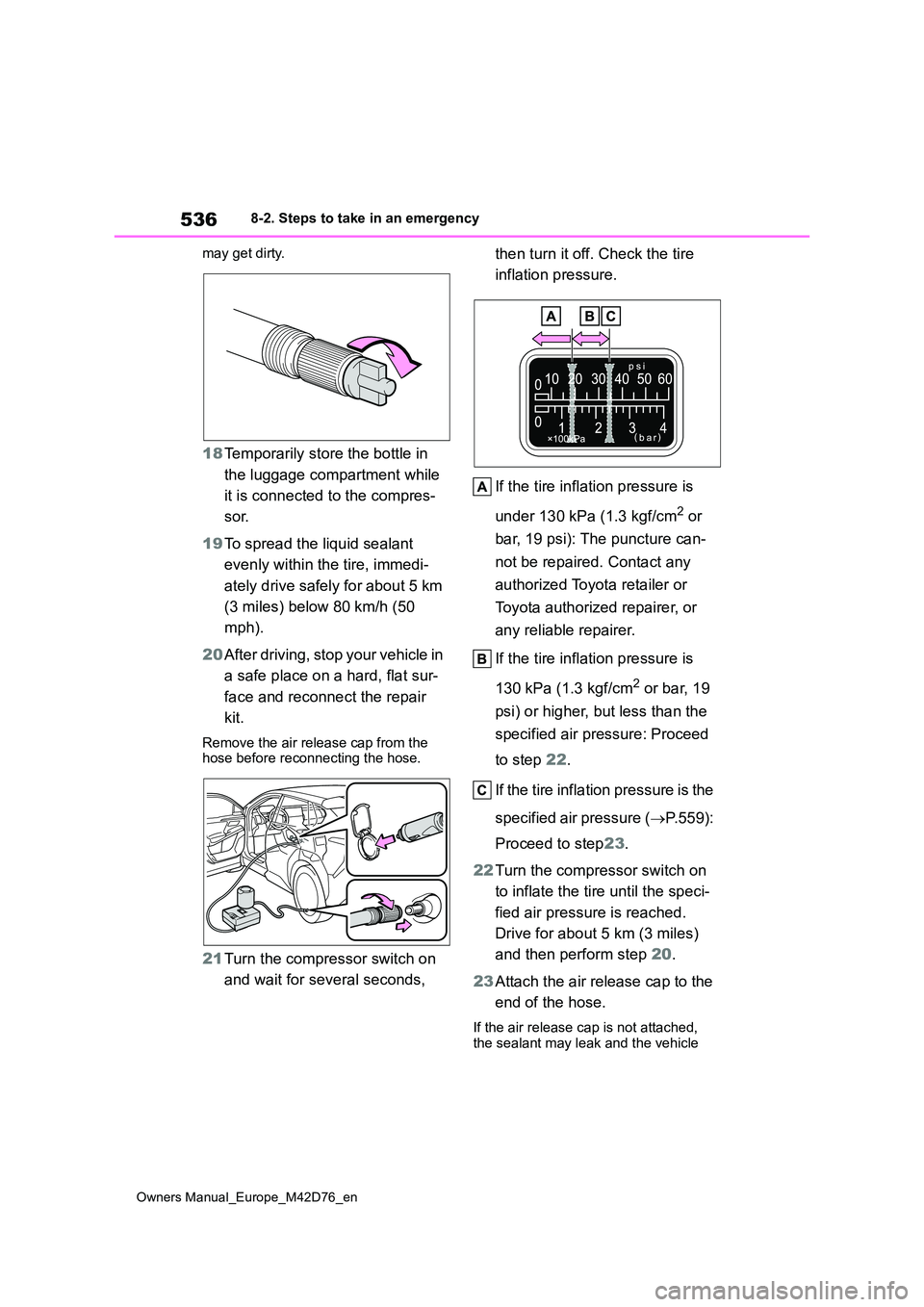
536
Owners Manual_Europe_M42D76_en
8-2. Steps to take in an emergency
may get dirty.
18 Temporarily store the bottle in
the luggage compartment while
it is connected to the compres-
sor.
19 To spread the liquid sealant
evenly within the tire, immedi-
ately drive safely for about 5 km
(3 miles) below 80 km/h (50
mph).
20 After driving, stop your vehicle in
a safe place on a hard, flat sur-
face and reconnect the repair
kit.
Remove the air release cap from the hose before reconnecting the hose.
21 Turn the compressor switch on
and wait for several seconds,
then turn it off. Check the tire
inflation pressure.
If the tire inflation pressure is
under 130 kPa (1.3 kgf/cm2 or
bar, 19 psi): The puncture can-
not be repaired. Contact any
authorized Toyota retailer or
Toyota authorized repairer, or
any reliable repairer.
If the tire inflation pressure is
130 kPa (1.3 kgf/cm2 or bar, 19
psi) or higher, but less than the
specified air pressure: Proceed
to step 22.
If the tire inflation pressure is the
specified air pressure ( P.559):
Proceed to step 23.
22 Turn the compressor switch on
to inflate the tire until the speci-
fied air pressure is reached.
Drive for about 5 km (3 miles)
and then perform step 20.
23 Attach the air release cap to the
end of the hose.
If the air release cap is not attached, the sealant may leak and the vehicle
Page 539 of 674
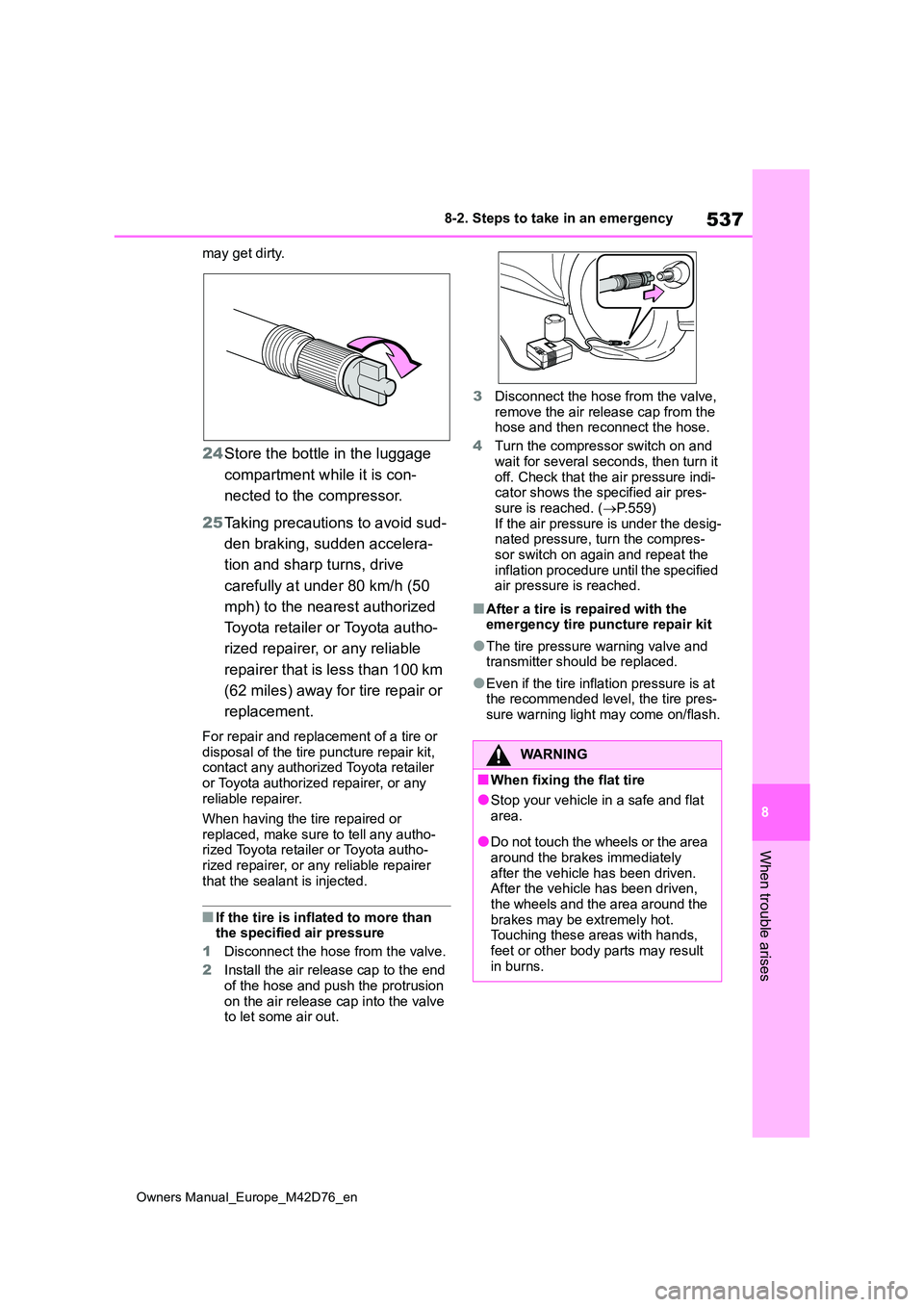
537
8
Owners Manual_Europe_M42D76_en
8-2. Steps to take in an emergency
When trouble arises
may get dirty.
24Store the bottle in the luggage
compartment while it is con-
nected to the compressor.
25 Taking precautions to avoid sud-
den braking, sudden accelera-
tion and sharp turns, drive
carefully at under 80 km/h (50
mph) to the nearest authorized
Toyota retailer or Toyota autho-
rized repairer, or any reliable
repairer that is less than 100 km
(62 miles) away for tire repair or
replacement.
For repair and replacement of a tire or disposal of the tire puncture repair kit, contact any authorized Toyota retailer
or Toyota authorized repairer, or any reliable repairer.
When having the tire repaired or
replaced, make sure to tell any autho- rized Toyota retailer or Toyota autho-rized repairer, or any reliable repairer
that the sealant is injected.
■If the tire is inflated to more than the specified air pressure
1 Disconnect the hose from the valve.
2 Install the air release cap to the end of the hose and push the protrusion
on the air release cap into the valve to let some air out.
3 Disconnect the hose from the valve,
remove the air release cap from the hose and then reconnect the hose.
4 Turn the compressor switch on and wait for several seconds, then turn it
off. Check that the air pressure indi- cator shows the specified air pres-sure is reached. ( P.559)
If the air pressure is under the desig- nated pressure, turn the compres-sor switch on again and repeat the
inflation procedure until the specified air pressure is reached.
■After a tire is repaired with the emergency tire puncture repair kit
●The tire pressure warning valve and transmitter should be replaced.
●Even if the tire inflation pressure is at the recommended level, the tire pres-
sure warning light may come on/flash.
WARNING
■When fixing the flat tire
●Stop your vehicle in a safe and flat
area.
●Do not touch the wheels or the area
around the brakes immediately after the vehicle has been driven. After the vehicle has been driven,
the wheels and the area around the brakes may be extremely hot. Touching these areas with hands,
feet or other body parts may result in burns.
Page 540 of 674
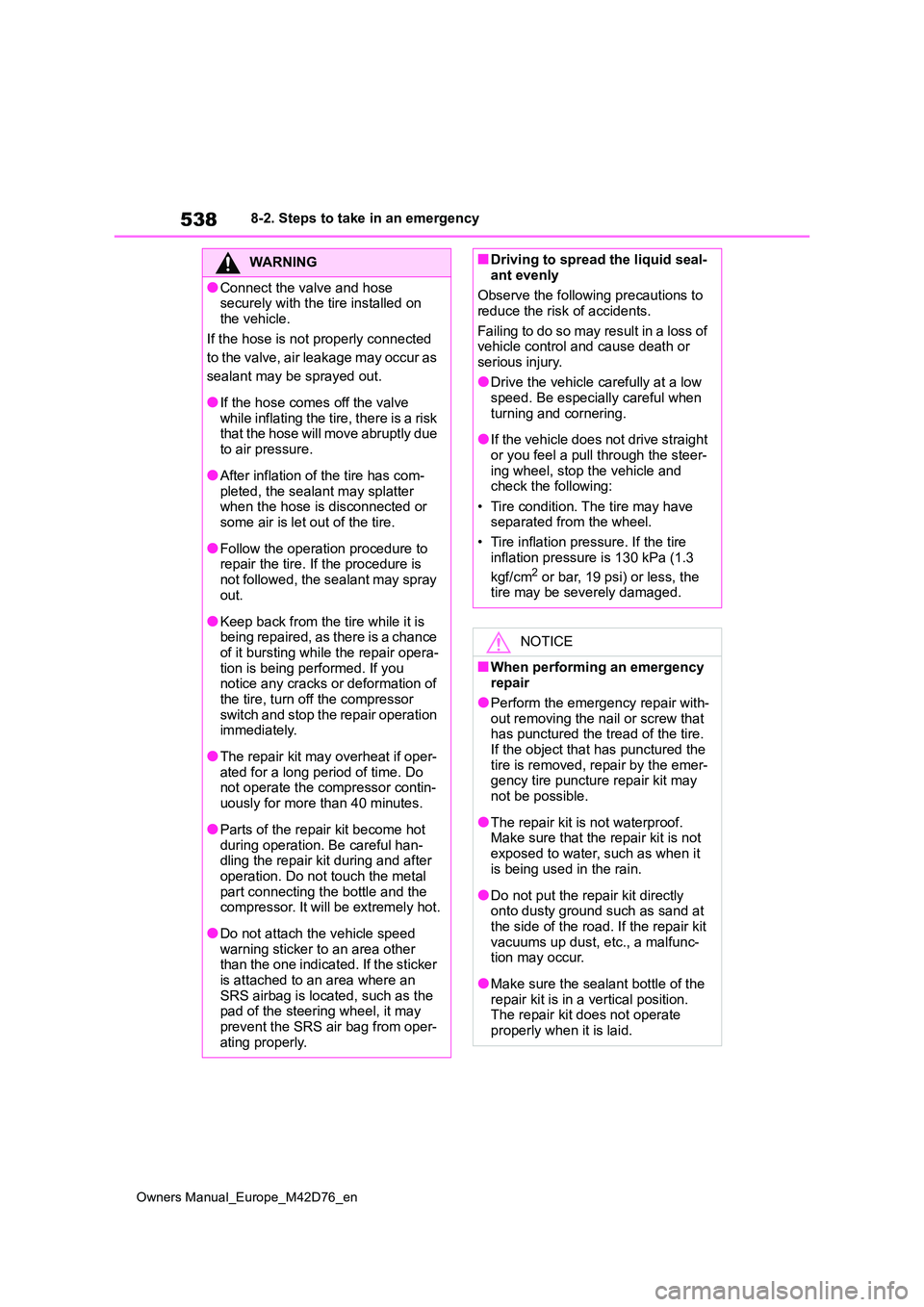
538
Owners Manual_Europe_M42D76_en
8-2. Steps to take in an emergency
WARNING
●Connect the valve and hose securely with the tire installed on
the vehicle.
If the hose is not properly connected
to the valve, air leakage may occur as
sealant may be sprayed out.
●If the hose comes off the valve while inflating the tire, there is a risk that the hose will move abruptly due
to air pressure.
●After inflation of the tire has com-
pleted, the sealant may splatter when the hose is disconnected or some air is let out of the tire.
●Follow the operation procedure to repair the tire. If the procedure is
not followed, the sealant may spray out.
●Keep back from the tire while it is being repaired, as there is a chance of it bursting while the repair opera-
tion is being performed. If you notice any cracks or deformation of the tire, turn off the compressor
switch and stop the repair operation immediately.
●The repair kit may overheat if oper-ated for a long period of time. Do not operate the compressor contin-
uously for more than 40 minutes.
●Parts of the repair kit become hot
during operation. Be careful han- dling the repair kit during and after operation. Do not touch the metal
part connecting the bottle and the compressor. It will be extremely hot.
●Do not attach the vehicle speed warning sticker to an area other than the one indicated. If the sticker
is attached to an area where an SRS airbag is located, such as the pad of the steering wheel, it may
prevent the SRS air bag from oper- ating properly.
■Driving to spread the liquid seal-ant evenly
Observe the following precautions to
reduce the risk of accidents.
Failing to do so may result in a loss of vehicle control and cause death or
serious injury.
●Drive the vehicle carefully at a low speed. Be especially careful when
turning and cornering.
●If the vehicle does not drive straight
or you feel a pull through the steer- ing wheel, stop the vehicle and check the following:
• Tire condition. The tire may have separated from the wheel.
• Tire inflation pressure. If the tire
inflation pressure is 130 kPa (1.3
kgf/cm2 or bar, 19 psi) or less, the tire may be severely damaged.
NOTICE
■When performing an emergency repair
●Perform the emergency repair with-
out removing the nail or screw that has punctured the tread of the tire. If the object that has punctured the
tire is removed, repair by the emer- gency tire puncture repair kit may not be possible.
●The repair kit is not waterproof. Make sure that the repair kit is not
exposed to water, such as when it is being used in the rain.
●Do not put the repair kit directly onto dusty ground such as sand at the side of the road. If the repair kit
vacuums up dust, etc., a malfunc- tion may occur.
●Make sure the sealant bottle of the repair kit is in a vertical position. The repair kit does not operate
properly when it is laid.